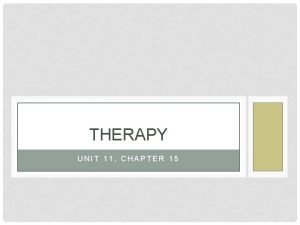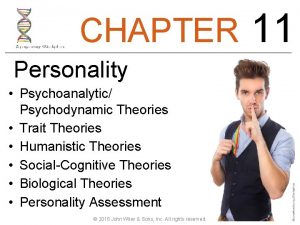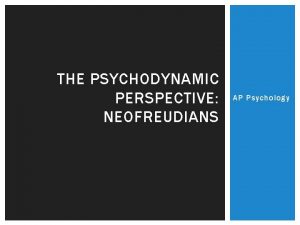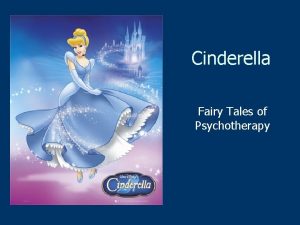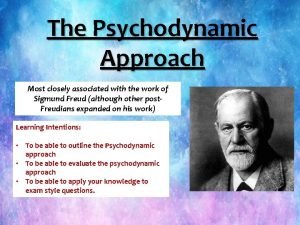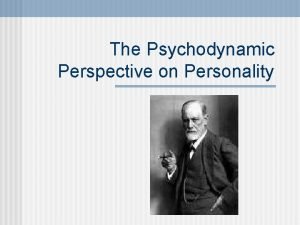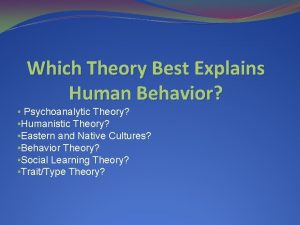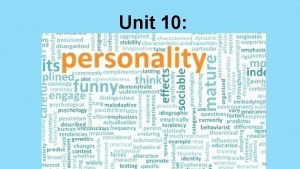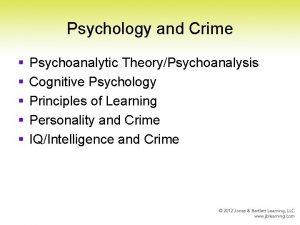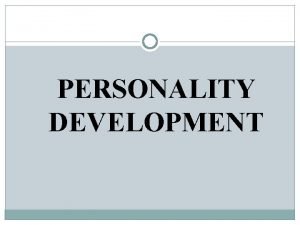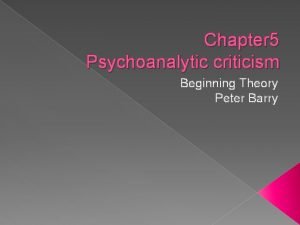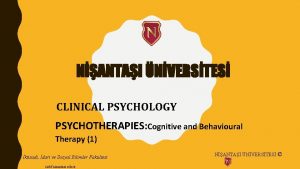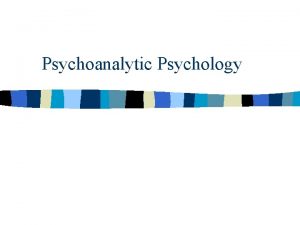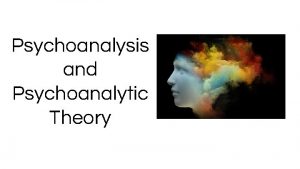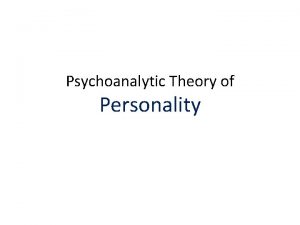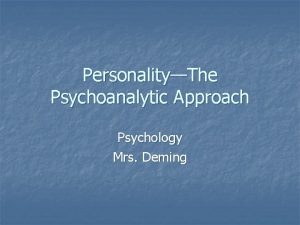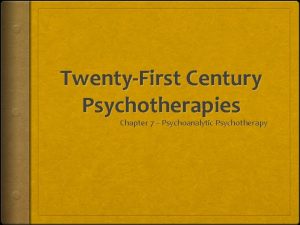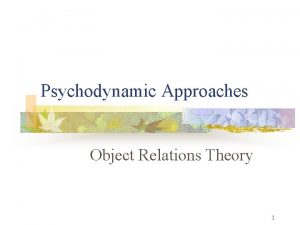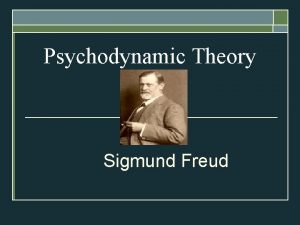NANTAI NVERSTES CLINICAL PSYCHOLOGY PSYCHOTHERAPIES Psychoanalytic theory Psychodynamic
















- Slides: 16

NİŞANTAŞI ÜNİVERSİTESİ CLINICAL PSYCHOLOGY PSYCHOTHERAPIES: Psychoanalytic theory & Psychodynamic perspective (2) İktisadi, İdari ve Sosyal Bilimler Fakültesi iisbf. nisantasi. edu. tr NİŞANTAŞI ÜNİVERSİTESİ ©

The Ego Defenses ● ● ● Inevitable (kaçınılmaz) conflict between the id, ego, and superego lead to anxiety and discomfort and the need to utilize (kullanmak, yararlanmak) ego defense mechanism. Defense mechanism are strategies ‘developed by the ego to protect the person from these internal and mostly unconscious conflict. ’ Examples, repression (keeping unpleasant thoughts, feeling, wishes, and conflicts out of consciousness), denial (denying that problematic feelings, thoughts, or behaviors exist).

Seven Key Features of Psychodynamic Psychotherapy ● Encourages patients to focus on affect and the expression of emotion. ● Helps people explore their attempts to avoid distressing thoughts and feelings. ● Identifies and focuses on recurring themes and patterns in patients’ thoughts, feelings, and behaviors. ● Helps patients discuss how past experiences affect their current relationships, feelings, and behavior. ● Focuses on interpersonal relationships and interpersonal experience. ● Focuses on the current therapy relationship. ● Encourages patients to explore fantasy life (e. g. , uncensored thoughts, feelings, dreams). Source: Adapted from “The efficacy of psychodynamic psychotherapy. ” American Psychologist, 65, pp. 98 – 109. Copyright © 2010 by the American Psychological Association. Reprinted by permission.

The Aim Of Psychoanalytic Treatment ● ● According to Magnavita, the general aim of psychoanalytic treatment is to overcome the developmental barriers and personality patterns that hamper(engel olan) the person's ability to function with the highest possible level of capacity. Strupp et al. (1982) described the basis of psychoanalytic treatment as using current interpersonal relationships to fix existing problems created by interpersonal relationships in the past.

The Aim Of Psychoanalytic Treatment: Therapeutic Goals 1 - To establish a strong therapeutic relationship 2 - To make the unconscious: Self-understanding - Conscious awareness 3 - To provide a general change in personality and character structure : To change maladaptive symptoms, signs and behaviors. 4 - To strengthen the ego: The fears, selfish needs, violent motives, unacceptable sexual desires, irrational wishes, shameful experiences are brought to conscious. ● Therapeutic methods are used to bring out unconscious. ● It Focuses primarily on childhood experiences. ● Childhood experiences are reconstructed, discussed, interpreted, and analyzed.

The Therapeutic Process: Therapist’s Function and Role One of the central functions of analysis is to help clients acquire the freedom to love, work, and play. • Other functions include assisting clients in achieving self-awareness, honesty, and more effective personal relationships; in dealing with anxiety in a realistic way; and in gaining control over impulsive and irrational behavior. • The analyst must first establish a working relationship with the client and then do a lot of listening and interpreting. • Particular attention is given to the client’s resistances. The analyst listens, learns, and decides when to make appropriate interpretations. •

From Theory to Practice: Techniques of Psychodynamic Psychotherapy ● Free Association ● Analysis of Dreams ● Resistance ● Transference ● Interpretation

1) Free association is a therapy technique in which the clients say whatever comes to mind without self-censorship. Clients must say anything and everything that comes mind. • In free association, clients talk about their feelings, experiences, associations, memories, and fantasies to the analyst. •

2) Analysis of Dream analysis and interpretation Dreams are thought to reveal the nature of the unconscious because they are regarded as heavily laden with unconscious wishes, in symbolic form. For example, the manifest content (belirgin içerik) of a dream may be that one is confronted with two large, delicious – looking ice cream cones. The latent content (gizli(örtük) içerik) of a dream is its symbolic meaning. In the preceding example, perhaps there is a message about need for oral gratification or a longing to return to the mother’s breast.

3) Resistance The term resistance is used to describe any client action or behavior that prevents insight or prevents bringing unconscious material into consciousness. Resistance takes many forms. • Patients may begin to talk less, to pause longer, or to report their minds are blank. Lengthy silences are also frequent. Sometimes a patient may repeatedly talk around a point or endlessly repeat the same material. •

4) Transferance ● The therapist tries to form a transferance relationship with the client in therapy sessions. ● In a therapy context, transference refers to redirection of a patient's feelings for a significant people in a person’s present environmment to therapist (rage, hatred, mistrust, parentification, extreme dependence) ● Transference is often manifested as an erotic attraction towards a therapist. ● Therapist engage in very little self-disclosure and maintain a sense of neutrality to foster transferance. ● This transference relationship, is a cornerstone of psychoanalysis.

● ● ● Transference involves the projection of early relationship dynamics onto therapist who represents an authority figure similar to patient’s parents, for example. Transference can take many forms. It may be reflected in comments about therapist’s clothing or office furnishings. It may take the form direct comments of admiration, dislike, love or anger. The important point is that these reactions do not reflect current realities but have their roots in childhood.

Countertransference involves projection by therapist onto the patient in response to the patient’s transference behavior.

5) Interpretation From the psychoanalyst’s perspective, interpretation is the method by which the unconscious meaning of thoughts and behavior is revealed. Psychoanalytic Alternatives Psychoanalytic theory underwent considerable modification by the neo-Freudians, Alfred Adler, Carl Junk, Otto Rank, the ego analysts, and others.

The Economics of Psychotherapy By its very nature (reconstruction of the personality), psychoanalysis is a long and costly procedure. Its course over 3 to 5 years and the long costly preparation of its practitioners ensure that it will be an expensive undertaking.

REFERENCES A General Introduction to Psychoanalysis, Sigmund Freud. 1. Clinical Psychology, Timothy J. Trull - Mitchell J. Prinstein, Wadsworth Publishing, (2012). 2. Introduction To Clinical Psychology / Seventh Edition by Geoffrey P. Kramer, Douglas A. Bernstein, Vicky Phares 3. Introduction to Clinical Psychology / Edited by Lynda A. Heiden and Michel Hersen - Springer Science 4. Clinical Psychology: A Modern Health Profession / 1 st Edition by Wolfgang Linden , Paul Hewitt - Nobel 5. NİŞANTAŞI ÜNİVERSİTESİ ©
 Psychoanalytic and psychodynamic
Psychoanalytic and psychodynamic Nantai cash
Nantai cash Nantai 37
Nantai 37 Difference between psychoanalysis and psychodynamic
Difference between psychoanalysis and psychodynamic Freud's five stages of psychosexual development
Freud's five stages of psychosexual development Psychodynamic perspective ap psychology
Psychodynamic perspective ap psychology Commonalities among psychotherapies
Commonalities among psychotherapies 3 commonalities among psychotherapies
3 commonalities among psychotherapies Cinderella therapy
Cinderella therapy Pros and cons of psychodynamic theory
Pros and cons of psychodynamic theory Intellectualization defense mechanism
Intellectualization defense mechanism Psychoanalytic theory
Psychoanalytic theory Sigmund freud theories
Sigmund freud theories Psychoanalytic theory criminology
Psychoanalytic theory criminology Sigmund freud psychoanalytic theory
Sigmund freud psychoanalytic theory Psychoanalysis example
Psychoanalysis example Psychoanalytic theory criticism
Psychoanalytic theory criticism



